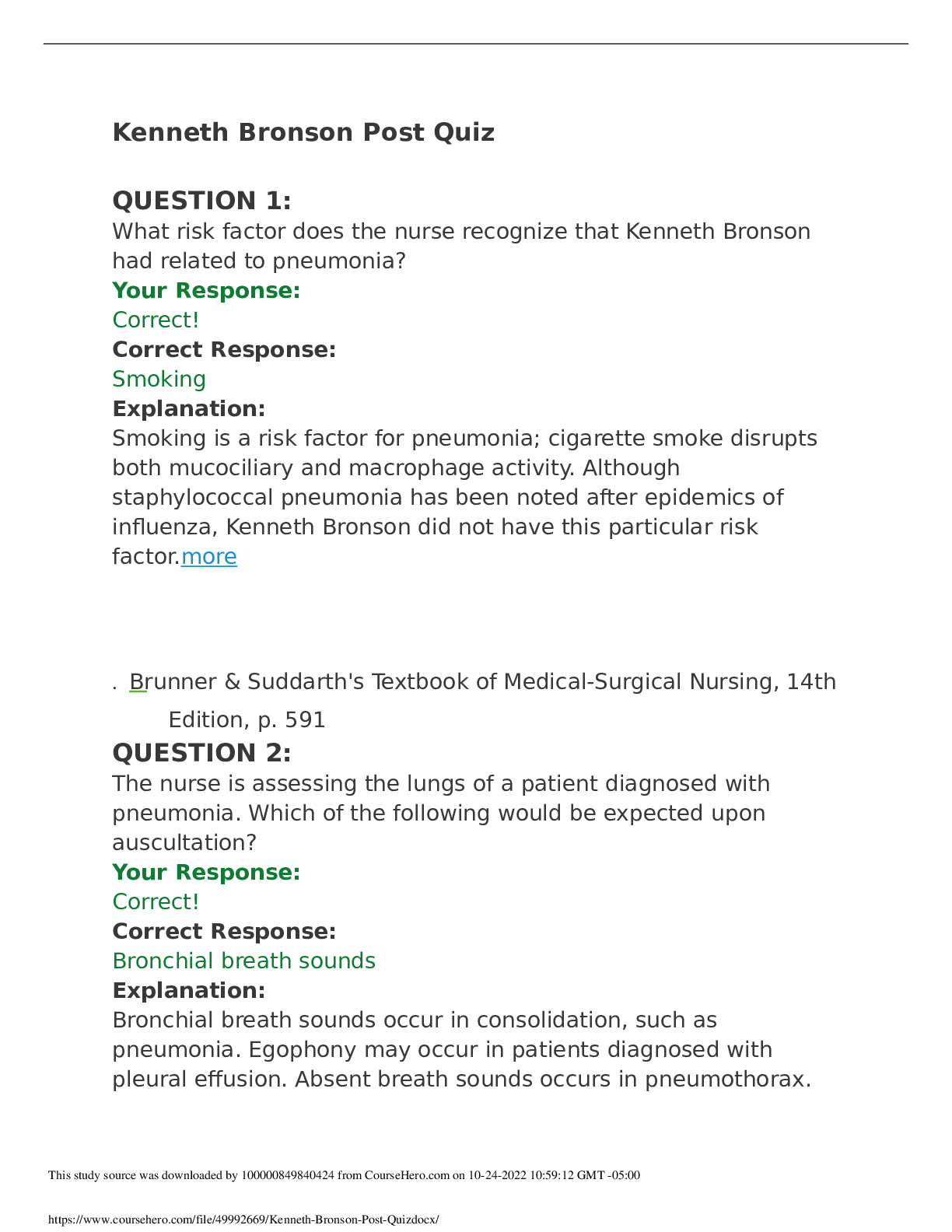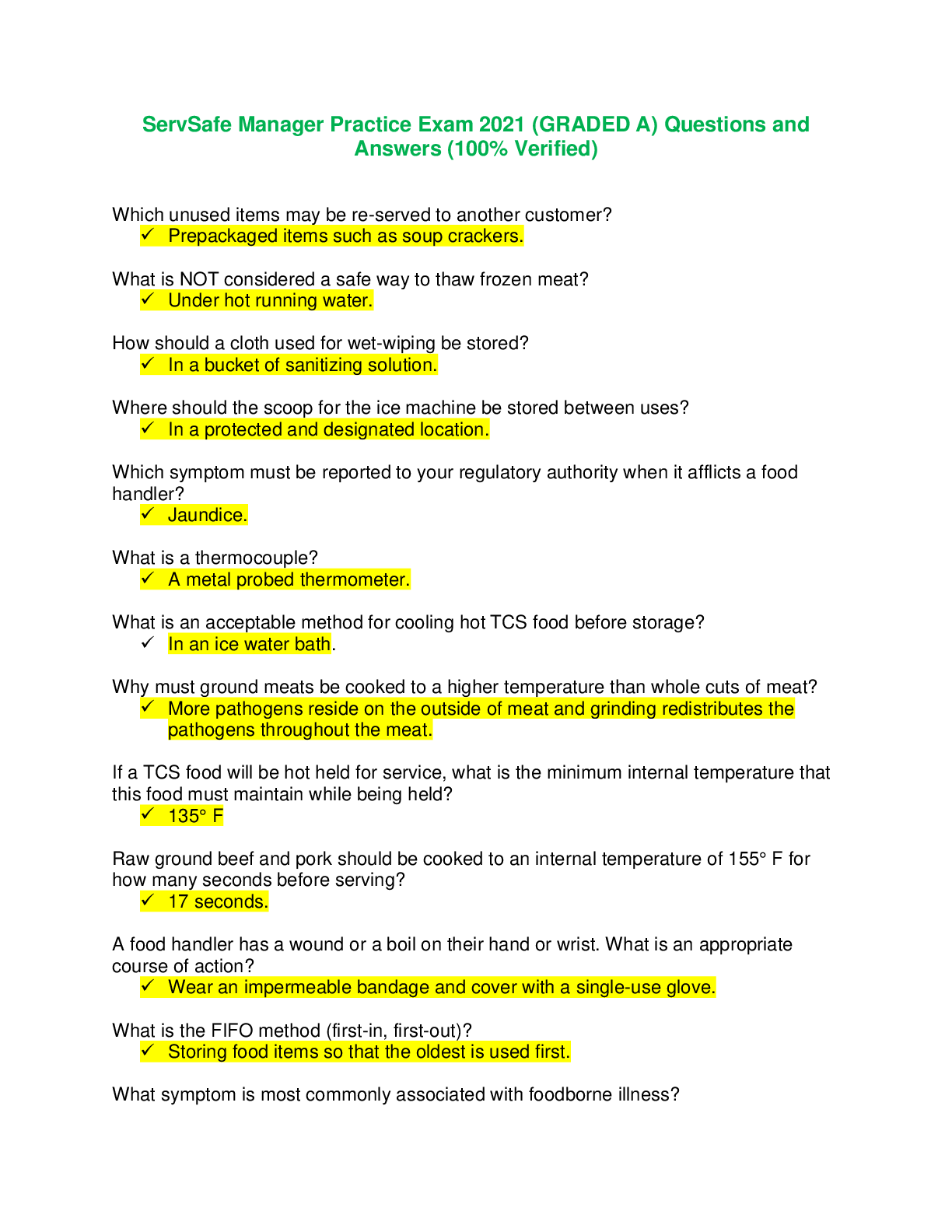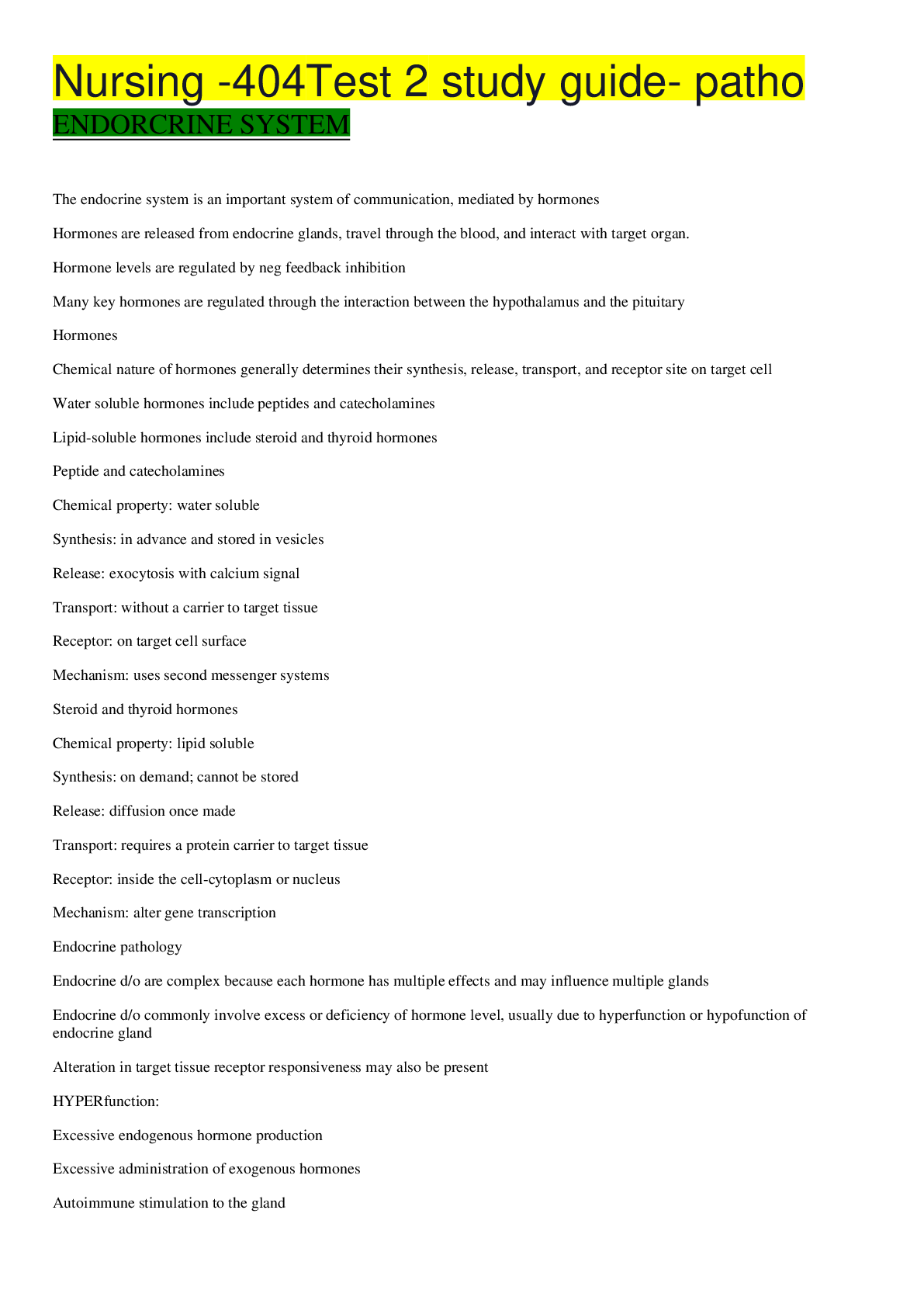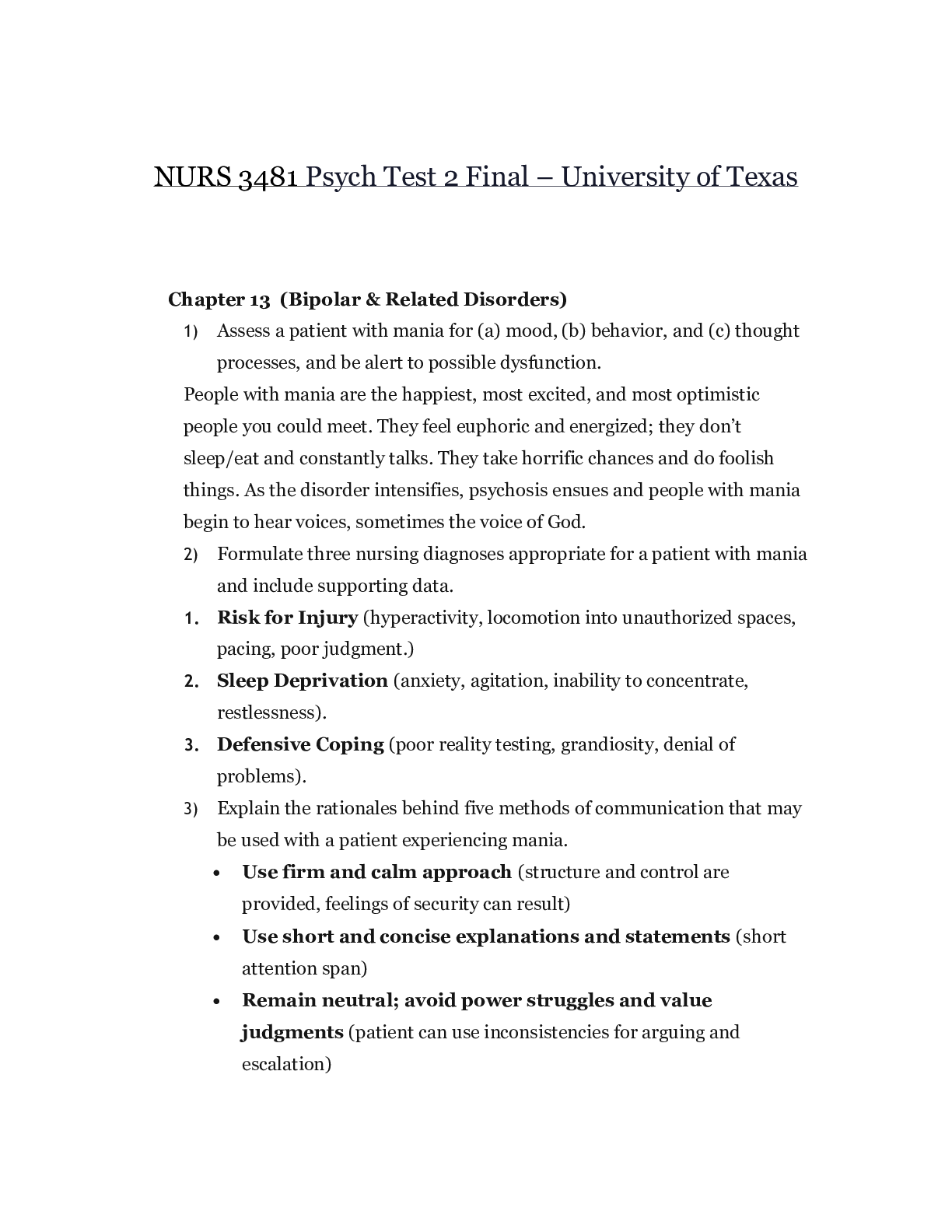Micro Biology > EXAM > MICROBIOLO 242 Test 1 and Test 2 (100% Correct Answers). (All)
MICROBIOLO 242 Test 1 and Test 2 (100% Correct Answers).
Document Content and Description Below
MICROBIOLO 242 Test 1 and Test 2 (TCO 1) The swan-necked flasks of Pasteur’s experiments Student Answer: allowed for airflow without allowing the introduction of environmental microbes... . turned the flask cloudy. contributed to supporting the theory of spontaneous generation. allowed the flasks to temporarily turn cloudy and then become clear after a period of time. All of the above Instructor Explanation: Chapter 1, The Golden Age of Microbiology section Question 2. Question : (TCO 1) Which of the following is NOT a characteristic of algae? Student Answer: They reproduce asexually by budding. They may be single celled or multicellular. They are photosynthetic. They are eukaryotic organisms. They provide much of the world’s oxygen. Instructor Explanation: Chapter 1, The Early Years of Microbiology section Question 3. Question : (TCO 1) What is metabolism? Student Answer: It is a calculation of how quickly food can be broken down. It is the building of more complex structures from subunits in an organism. It is the sum of all of the chemical reactions in an organism. It is the breakdown of large molecules into individual subunits. It is the production of glucose by a plant cell. Instructor Explanation: Chapter 1, The Golden Age of Microbiology section Question 4. Question : (TCO 1) Why are microorganisms so important to our ecosystems? Student Answer: They enrich soil. They degrade wastes. They support life. None of the above All of the above Instructor Explanation: Chapter 1, Introduction page Question 5. Question : (TCO 2) Photosynthetic bacteria Student Answer: produce glucose and oxygen. may also be nitrogen fixers. have chloroplasts. cannot tolerate oxygen in their environment. all have heterocysts. Instructor Explanation: Chapter 11, Survey of Bacteria section Question 6. Question : (TCO 2) Which of the following statements is NOT true about endospores? Student Answer: They are reproductive structures. They are formed by the Clostridium species. They may be classified as central, subterminal, or terminal. They are formed when conditions are suboptimal. Endospore-forming bacteria cause tetanus and anthrax. Instructor Explanation: Chapter 11, General Characteristics of Prokaryotic Organisms section Question 7. Question : (TCO 2) What is the potential overall magnification of a microscope that has a 10X ocular lens and a 40X objective lens? Student Answer: 10X 40X 390X 400X 410X Instructor Explanation: Chapter 4, Microscopy section Question 8. Question : (TCO 2) Which type of microscope would best be used to look at the atomic level? Student Answer: Phase contrast microscope Dark-field microscope Scanning tunneling microscope Scanning electron microscopes Confocal microscope Instructor Explanation: Chapter 4, Microscopy section Question 9. Question : (TCO 2) Carl Woese found that methanogens were not bacteria by sequencing their Student Answer: DNa. proteins. rRNa. tRNa. mRNa. Instructor Explanation: Chapter 4, Classification and Identification of Microorganisms section Question 10. Question : (TCO 2) How is the information in a dichotomous key arranged? Student Answer: It is usually arranged so the species will move from a bottom-to- top approach to determine if a cell is Gram positive or Gram negative. It is arranged as a stepwise choice between paired characteristics. It allows three possible outcomes as the organisms are moved down from one level to the next. It is arranged as a pyramid. It is arranged in concentric circles. Instructor Explanation: Chapter 4, Classification and Identification of Microorganisms section (TCO 3) Which of the following processes does not require ATP? Student Answer: Facilitated diffusion Group translocation Active transport All of the above require ATP None of the above require ATP Instructor Explanation: Chapter 3, Bacterial Cytoplasmic Membranes section Question 2. Question : (TCO 3) Which of the following is paired correctly? Student Answer: Facilitated diffusion: Antiport Osmosis: Carbon dioxide Group translocation: Glucose Diffusion: Permease Active transport: Water Instructor Explanation: Chapter 3, Bacterial Cytoplasmic Membranes section Question 3. Question : (TCO 3) Archaea and bacteria are similar in that Student Answer: they both have cell walls composed of peptidoglycan. neither have membrane-bound organelles. neither have lipids in their cell membranes. they both have an outer membrane containing Lipid A. they both have fimbriae and hami to help them attach to surfaces. Instructor Explanation: Chapter 3, Cell Structure and Function section Question 4. Question : (TCO 3) What is the shape and arrangement of Streptococci bacteria? Student Answer: Coccus shape; arranged in chains Rod shape; arranged in chains Coccus shape; arranged in clusters Coccus shape; arranged in palisades None of the above Instructor Explanation: Chapter 3, Bacterial Cell Walls section Question 5. Question : (TCO 5) Which of the following is an example of a catabolic reaction? Student Answer: Proteins being made through the process of translation. Cyanobacteria using the sun’s energy to synthesize glucose from carbon dioxide and water. A culture of Acetobacter is fermenting apples to produce apple cider vinegar. Gram positive bacteria making peptidoglycan to incorporate in their cell walls. A cell making starch, a polymer of glucose molecules. Instructor Explanation: Chapter 5, Carbohydrate Catabolism, Photosynthesis, and Other Anabolic Reactions sections Question 6. Question : (TCO 5) Which of the following statements about glycolysis is CORRECT? Student Answer: The majority of ATP produced during cellular respiration is produced during glycolysis. If an organism is growing on glucose, it must be using glycolysis. No ATP is consumed during glycolysis. The purpose of glycolysis is to split a molecule of glucose into two molecules of pyruvic acid. Glycolysis is also known as the Entner-Doudoroff pathway. Instructor Explanation: Chapter 5, Glycolysis section Question 7. Question : (TCO 5) Which of the following is an example of an anabolic reaction? Student Answer: Bacteria fermenting the lactose in milk to form lactic acid. A protozoan synthesizing glycogen from glucose molecules. Cyanobacteria breaking down ribulose via the pentose phosphate pathway. Pseudomonas cells using cellular respiration to produce carbon dioxide, water, and ATP from glucose. Yeast fermenting sucrose to produce ethanol and carbon dioxide. Instructor Explanation: Chapter 5, Carbohydrate Catabolism and Photosynthesis sections Question 8. Question : (TCO 5) Beverly has isolated a new species of bacterium from a jar of pickles. This bacterium is most likely a Student Answer: strict aerobe. neutrophile. barophile. halophile. thermophile. Instructor Explanation: Chapter 6, Growth Requirements section Question 9. Question : (TCO 5) During log phase, Student Answer: new cells are being produced at the same rate as other cells are dying. cells are dying faster than new cells are being reproduced. cells are metabolically active but not dividing. cells are rapidly growing and dividing. cells are adjusting to their new environment. Instructor Explanation: Chapter 6, Growth of Microbial Populations section Question 10. Question : (TCO 5) Low temperatures, such as 10° C, are ideal for the growth of which category of microbes? Student Answer: Psychrophiles Mesophiles Thermophiles Hyperthermophiles Hypothermophiles Instructor Explanation: Chapter 6, Temperature section (TCO 5) A microbiologist inoculates a growth medium with 200 bacterial cells/ml. If the generation time of the species is 1.5 hours, (a) how many generations will it take for the culture to contain more than 6,000 cells/ml? (5 pts.) (b) how long, in hours, will it be before the culture contains more than 6,000 cells/ml? Show your calculations. (5 pts.) Student Answer: A. In order to figure out how many generation it will take to culture more than 6000 cell you must apply the following math equation: When the population begins with more than one individual, then the final population equals: original number of cells × 2 number of generations... So you take the number of cell 200 x 2e5 and you will get 6400. So 200 cells producing five generations would produce 6400 cells. Final answer > 5 generations. B. In order to complete this problem one must apply the following math problem: number of generation= log number of cells at the end of generation minus log number of cells initially and then divide by log 2. So, log 6000- log 200 / log 2 equals 5. So, take to 5 (five genrations) and multiply it by the number of given hours of 1.5 hours. 5*1.5 which equals 7.5 hours Instructor Explanation: Chapter 6, The Growth of Microbial Populations section (a) Number of generations = 5 (b) Number of hours = 5 x 1.5 = 7.5 hours (TCO 2) A microbiologist just started a new job in a laboratory studying bacteria and viruses found in fecal samples. The laboratory has both a light microscope and an electron microscope. (a) How are these two types of microscopes similar? How are they different? (5 pts.) (b) Give an example of when the microbiologist might use a light microscope in her studies and when she would need to use an electron microscope. (5 pts.) Student Answer: Electron microscope can be used to see smaller things such as viruses. Light microscope can not be used to view viruses. Light microscopes are broken into simple microscopes and compound microscopes. Compound microscopes have multiple lenses and more clarity options compared to the simple one lens microscope. You can use a light microscope to view protozoan and or chloroplast. The resolution of light microscopes have resolution limitation due to the wavelengths of lights. Although both the light microscope and electron microscope can both be used to magnified objects, with electron microscope you can get greater resolution than the light microscope because the electron microscope uses electrons verses wavelengths. Electron microscopes can magnify up to 2 billion times the specimen whereas the light microscope can only magnify up to 2000 times the size of the specimen. Both type of microscopes have resolution limitations. The light microscope was created before the electron microscope. Instructor Explanation: Chapter 4, Microscopy section (a) Similarities: Both the light microscope and the electron microscope depend on the wavelength of radiation to achieve the resolution necessary to see fine details of specimens. Both can be used to increase magnification to see objects. Differences: Light microscopes use light rays, which, because of their relatively long wavelengths, limit the magnification of these microscopes to 2,000× or less. Electron beams, by contrast, have such a short wavelength that the resolution is greatly increased, to the point that magnification of 100,000× or more is possible. In a light microscope, the light rays are focused using glass lenses, whereas in an electron microscope, the electron beam is focused with magnetic fields. Because of their higher levels of magnification and extreme resolving power, electron microscopes are capable of revealing the finest details of the cell's ultrastructure, even molecules and atoms; light microscopes are capable of revealing only the larger cellular structures, such as organelles. (b) Answers will vary. The microbiologist could use the light microscope for studying bacteria or larger objects and use the electron microscope for studying viruses or bacterial structure. (TCO 6) Prions may be inactivated by Student Answer: autoclaving. enzymes. Pasteurization. phenol. isopropanol. Instructor Explanation: Chapter 9, Enzymes section Question 2. Question : (TCO 6) A physical method to control microbial growth is radiation. Which wavelength of radiation is most suitable to control microbial growth? Student Answer: Short-wavelength radiation Medium-wavelength radiation Long-wavelength radiation A wavelength of radiation that carries the least amount of energy Wavelength of radiation is not a factor for controlling microbial Instructor Explanation: growth. Chapter 9, Radiation section Question 3. Question : (TCO 6) A scientist has developed a new vaccine against malaria that needs to be administered by injection. Which method should be used to sterilize a solution of the new vaccine? Student Answer: Autoclaving Filtration Dilution with 70% ethanol Lyophilization UV irradiation Instructor Explanation: Chapter 9, Filtration section Question 4. Question : (TCO 6) Household bleach is an example of which of the following group of chemical antimicrobial agents? Student Answer: Halogens Phenolics Alcohols Aldehydes Surfactants Instructor Explanation: Chapter 9, Halogens section Question 5. Question : (TCO 6) Which of the following statements about sanitization is true? Student Answer: Sanitization refers to the destruction of all microbes on an object. Sanitization reduces the number of pathogenic microbes in milk and other beverages. Sanitization involves the use of disinfectants in public places. Sanitization is the removal of microbes from the surface of the skin by scrubbing. A sanitized object is free of microbial contaminants. Instructor Explanation: Chapter 9, Terminology of Microbial Control section Question 6. Question : (TCO 6) Which of the following statements about antibiotic resistance is correct? Student Answer: Resistance is often mediated by F plasmids. Resistant cells are usually the majority of a bacterial population. Resistant cells grow much more efficiently than sensitive cells. Resistance can occur through DNA mutations. Antibiotic resistance always requires the presence of beta- Instructor Explanation: lactamase. Chapter 10, Resistance to Antimicrobial Drugs section Question 7. Question : (TCO 6) Which of the following is paired incorrectly? Student Answer: Quinolones: Inhibition of nucleic acid synthesis Amphotericin B: Disruption of cytoplasmic membranes Vancomycin: Inhibition of cell wall synthesis Tetracyclines: Inhibition of protein synthesis Erythromycin: Inhibition of metabolic pathways Instructor Explanation: Chapter 10, Mechanisms of Antimicrobial Action section Question 8. Question : (TCO 6) Which of the following antimicrobial drugs can cause damage to bones? Student Answer: Beta-lactams Aminoglycosides Quinolones Tetracyclines Sulfonamides Instructor Explanation: Chapter 10, Toxicity section Question 9. Question : (TCO 6) Which of the following is a measurement associated with the Kirby-Bauer test? Student Answer: Zone of inhibition Lack of turbidity Cell lysis Zone of inhibition and presence of turbidity Presence of turbidity and cell lysis Instructor Explanation: Chapter 10, Efficacy section Question 10. Question : (TCO 6) The first antibiotic that was used to treat a wide variety of infections was Student Answer: penicillin. arsenic. sulfanilamide. streptomycin. ciprofloxacin. Instructor Explanation: Chapter 10, The History of Antimicrobial Agents section 1. Question : (TCO 6) A number of methods of microbial control are used to help keep food fresh for a longer time. Describe how each of the foods listed below are treated to reduce microbial contamination. Be sure to describe how the method works, don’t just list the method used. (a) Raisins (b) Jelly (c) Spices (d) Raw fish Student Answer: Lyophilization can be used to microbial growth on raisins. That means that the product such as the raisin is drying in the sun to kill off microbes. It is also necessary to combine the drying process of the raisin with the freeze and drying process because raisin still have the potential to grow mold even after the desiccation process. The desiccation process is similiar to the lyophilization minus the freezing process. With the drying process the water is removed which prevent the spread of mold and bacteria growth; that is because mold and bacteria thrives off of water and can grow when a significant amount of water is remaining in the product such as a raisin. Jelly is preserved via osmotic pressure. Using osmotic pressure will reduce the water levels sugars or salts. The more water that is present in an item the larger chance of microbial growth. Microbes thrive in water. Salt is known to shrink and or reduce water levels even in human beings. Spices are reserved via irradiation. Species have the perfect structure in terms of size which allows irradiation to come in and zap electrons. Irradiation is a usage of radiation such as x-rays or gamma rays. Irradiation is also amazing in a since that it can kill off potential offspring of bugs. Irradiation also destroys cells. Cells allow microbes to grow and develop. Triakali metalat can be used to kill microbes in fish. Raw fish can be preserved via a freezing process. Freezing fish can allow the fish slow the process of microbial growth. However freezing fish will not destroy microbes. Instructor Explanation: Chapter 9, Physical Methods of Microbial Control section (a) Raisins are preserved through desiccation, or drying. Microbial metabolism requires water, so drying will inhibit many microbes and keep them from spoiling food or causing disease. (b) Jelly is preserved by adding a lot of sugar. The high sugar concentration causes the food (and any microbes that might be in the food) to lose water and dry out. This inhibits microbes from growing and keeps the food contamination free. (c) Spices are preserved by radiation. Radiation kills bacteria as well as insects, larvae, and eggs. (d) Raw fish is preserved by freezing it before consumption. This does not kill all bacteria present, however. [Show More]
Last updated: 2 years ago
Preview 1 out of 27 pages
.png)
Buy this document to get the full access instantly
Instant Download Access after purchase
Buy NowInstant download
We Accept:

Reviews( 0 )
$14.50
Can't find what you want? Try our AI powered Search
Document information
Connected school, study & course
About the document
Uploaded On
Oct 07, 2021
Number of pages
27
Written in
Additional information
This document has been written for:
Uploaded
Oct 07, 2021
Downloads
0
Views
100
 Questions and Answers GRADED A STRAIGHTLINE.png)





 Questions and Answers 100% VERIFIED.png)
 Questions and Answers 100% correct Solutions.png)



















